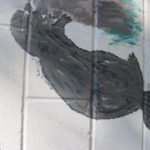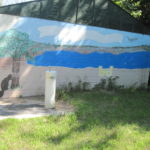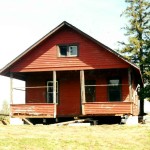Old YMCA Buildings
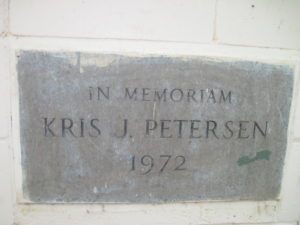
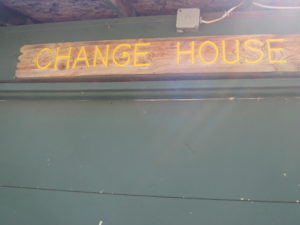 The YMCA Camp Manitou has been in operation at Bertram Lakes since 1972. It was located at the south entrance of the current park for over 35 years and has served many thousands of kids with a great camping experience. But, as we all know, times change and two of the original buildings were recently demolished as they had become in disrepair. The “main building” and the “change house” were the buildings removed.
The YMCA Camp Manitou has been in operation at Bertram Lakes since 1972. It was located at the south entrance of the current park for over 35 years and has served many thousands of kids with a great camping experience. But, as we all know, times change and two of the original buildings were recently demolished as they had become in disrepair. The “main building” and the “change house” were the buildings removed.
The change house was the place where campers would change into their swimsuits for their time at the beach. It was also used as a storage facility for the smaller sailboats on which the older campers learned to sail.
One year a group of campers decided to dress up the change house by painting the west end of the building. The scene was one of a lake (maybe Bertram) with pictures of some of the animals that inhabit the park ~ beaver, deer, loons, bass, cranes and trees. The only painting out of place is that of a castle. Each character had the name of the camper who painted it next to it. See the pictures in this tidbit.
The Witch Tree
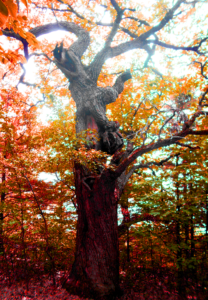 Halloween is the time of year when ghosts, witches and goblins appear to wreak havoc in the world! During the late 1990’s and early 2000’s, the staff at YMCA Camp Manitou created the “Trail of Terror” which would include ghosts, skeletons, goblins, witches, and zombies. The trail wound through some of the Bertram property where younger kids riding on a hay wagon would be “scared out of their wits” by the hidden Monsters! It became very popular among area kids and they would look forward to it each year as the leaves began to fall.
Halloween is the time of year when ghosts, witches and goblins appear to wreak havoc in the world! During the late 1990’s and early 2000’s, the staff at YMCA Camp Manitou created the “Trail of Terror” which would include ghosts, skeletons, goblins, witches, and zombies. The trail wound through some of the Bertram property where younger kids riding on a hay wagon would be “scared out of their wits” by the hidden Monsters! It became very popular among area kids and they would look forward to it each year as the leaves began to fall.
For many years, even today, because of the YMCA Camp, the area was referred to as Camp Manitou, a Native American name meaning “Mystical Spirit”. The Bertram Lakes have since become known for its mysteries as strange things have happened there. (See my earlier tidbit, “Hatchet Harry”)
One of these stores is in the form of a tree, the “Witch Tree”. The story is that of a witch who lived in and haunted the area in the past. She grew old but wished to live on, so she turned herself into a sturdy oak tree. She still haunts the woods today with her mangled arms and spooky warts!
I cannot tell you where she is because you need to explore and find her for yourself! When you find her, please take pictures to share, but “warning” don’t stand too close!
The Oscar Kiebel Farm
In an earlier Tidbit, I mentioned there were nine farms located on the Bertram Lakes property that were acquired, over time, by the Y.M.C.A. One of the last that was purchased was located on the east side of Briarwood Avenue a quarter mile north of 90th Street, and was known as the Oscar Kiebel Farm.
The house itself has an interesting history because it was an early version of the “pre-fab” houses, although in today’s terms it really wasn’t.
80 to 90 years ago, Sears and other companies were creating what was referred to as “Railroad Houses”. There were several designs to choose from but the basic concept was the same. All of the pieces of the house were pre-cut and marked to indicate what it was and where it went. For example, boards were marked as joists, rafters, studs, etc., and were numbered to show their position. A master plan showed where each board went and the carpenters or home owner simply followed the diagram.
At the factory after each house was cut and marked, it was packaged and sent by the railroad to the town nearest the final location of the home. In this case, it was shipped to the Monticello Railroad Depot to be picked up by the owner.
This house, in particular, served as the primary residence for the Oscar Kiebel family. This house is currently located near 90th Street, approximately one mile west of its original location.
Andrew Bertram Poem
Andrew H. Bertram was the eldest son of George Bertram. He was born July 15, 1842 in New York, New York. By 1862, after the Civil War broke out, he had answered the call to arms made by President Lincoln and enlisted in the Eighth Regiment, Company E of the Minnesota Volunteer Infantry.
Also, during that year came the outbreak of what has become known as the “Dakota War of 1862”. Andrew’s newly formed Company E was not sent to fight in the Civil War, as other volunteers were, but were sent to deal with the immediate crisis at home in Minnesota.
The following is an excerpt from Andrew’s poem written by him in 1878, as a tribute to his fellow volunteers. this portion of the poem covers only the period of time they spent in and around the Monticello and Bertram Lakes area.
We are ordered now to Ripley
Where we must learn the drill,
So we bid “Goodbye” to Snelling
And leave it with a will.
We then march to Monticello
Where our tents are quickly set
The circumstance of which, I think
Our Citizens don’t forget —
We were led to tables groaning
With the weight of richest food,
Which we ate with keenest relish
For our fare had not been good.
We were grateful for the blessings
Our Mothers had prepared
But the way we showed our gratitude
Looked as though we never cared.
The first night we stole chickens
Which created quite a fuss
But we were not suspected,
They never thought ’twas Us.
So things continued daily
The Boys were out each night
Some came back quite early
Others at broad daylight.
But they never came back empty
A Turkey, Pig or Sheep,
So we drew most all our retirees
While the Farmers were asleep.
At last we received orders
To continue on our way
And the People of Monticello
Thanked the Lord that day.
An Oak and its Acorn
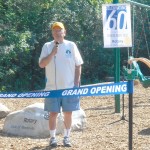 I have been asked to retell the story of the oak tree that I told at the opening ceremony of the Natural Theme Playground. I hope that it will be of interest to the readers.
I have been asked to retell the story of the oak tree that I told at the opening ceremony of the Natural Theme Playground. I hope that it will be of interest to the readers.
In June of 1985, I began working for the YMCA supervising summer youth employment students ages 14-17. One of the tasks was to make sure the beach area was clean and well organized. The “Y” Day Camp used the beach, as well as a few weekend campers.
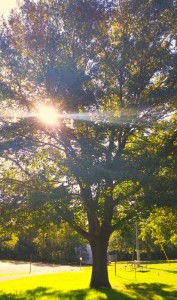
Next to the road that goes by the beach area was an old, hollowed out oak tree that was struggling to stay alive. As stated in an earlier tidbit, “Cecropia Moth”, many old oak tress rot from the inside out, with the cambium layer still alive. This old oak tree was definitely hollowed out with a couple of feet of sawdust chips in the center. Plus, there was one live branch growing out of the side that extended several feet into the air. This branch was still producing acorns and, in the past, one of them had fallen into the “sawdust” in the center of the tree. Miraculously, the acorn had taken root and was at least 7-8 feet tall!
Over the next two years, this old tree gave out and we had to cut down what was left of it. Without the old tree surrounding it, the new young oak grew stronger by itself and now, 40 years later, it is the magnificent tree that we can see and enjoy today (see picture at right)! But we must remember that nature renews itself in its own time and not in ours. Appreciate the tree for what it is, beauty, shade and renewal.
George Bertram in Excelsior
George Bertram was one of the founders of Excelsior, Minnesota, a town known for its history, both Native and Current.
But, what motivates a person who has become comfortable in the largest city in the United States, to gather his family and move to the “frontier”?
We cannot look inside the mind of the man but we can look at some of the historical events that may have influenced his decision.
1) The Traverse Du Sioux Treaty of 1851
As mentioned in a prior Tidbit, this treaty ceded to the United States Government most of the land of the current Minnesota from the Sioux. In so doing, the land was open for claim and settlement by the citizens of the United States. George must have seen this as a great opportunity, especially considering his religious views.
2) Religion
The era from 1825 – 1850 was a time of renewal and re-creation for religions in America, although the northern states still kept the basic community concept established by the Puritans and the Pilgrims. This concept held the belief that the community of the people and their faith was one and the same. George Bertram believed this and it was instrumental in his vision of Excelsior and eventually Monticello.
3) Technology
In the 1840’s two events were to affect George Bertram’s life. One was an expansion (railroads) and the other was an invention (sewing machine). Railroads (mostly privately owned) began opening up the frontier for settlement and George saw this as an opportunity to make his “dream” to create a new society come true. Couple this with Elias Howe’s invention of the sewing machine and he saw his chance. Remember, Bertram was a tailor and with the new sewing machine finding its way into the homes and factories, his livelihood was being threatened.
In 1952 Bertram made his way west, eventually landing in St. Anthony, Minnesota. From there he traveled west by ox cart and then boat to the west side of Lake Minnetonka where he made a government claim to 160 acres of land, later to become the city of Excelsior.
Upon his return to New York, Bertram began working on his plan to establish the Excelsior Pioneer Association and spent the winter of 1852-53 soliciting memberships. To be a member, the initial fee would be $8 and $1 per week dues for the next 8 months. Each member (male), self or family, was to be provided with a farm and one village lot of not less than 1 acre, selected by a drawing from the 160 acres.
In 1853 the Bertram’s arrived and built their home. George became the first president of the new “association” and church services were conducted in his home.
But, for various reasons that were speculated (religious, leadership, conditions, $, etc.) the Bertram’s moved back to St. Anthony in 1854. The town of Excelsior survived to become a thriving vacation spot for many years to come.
Wright County Mammoth Squash
The following quote appeared in the Minneapolis Farmer’s Union paper on April 5, 1873, edited by Col. J. H. Stevens:
“I sent you a few seeds of my Mammoth Squash. I raised it last year, and had it on exhibition at our county fair. It was far ahead of anything of the kind that had ever been seen here. It weighed 142 pounds, measured 6′, 7″ around length-ways and 5′, 9″ around over the top. The color was sage green, deeply ribbed and finely netted all over like a nutmeg melon. The flesh was from 6-8″ in thickness, and of a deep orange color. I baked some in the oven, and it was the sweetest squash I ever tasted. Everyone who saw it wanted seeds, so I have put them up in papers and am selling them. I got about 600 seeds from the squash. I was sorry I had not sent it to the State Fair. I heard there was one there that weighed 140 pounds. I think this is the largest one that has been raised in the State. I was going to call it Minnesota Mammoth Squash, but thought I would give the name to Wright County. We can raise as big things here as anywhere. There will be great strife in raising big squash up here this year. All who can get seeds are going to try. This package I send you is the only one that will leave the county, except one I send to a friend of mine in New Jersey. Let us hear what you can make out with it.
Yours truly,
Geo. M. Bertram.
Monticello, March 17,1873”
Note: Besides being a tailor by trade, George Bertram, along with his wife, Julia, were avid gardeners who grew much of their own fresh vegetables and fruits.
In the previous tidbit, Farms II, I mentioned that the farmers who owned and operated the Bertram Lakes land were stewards or “trustees” of the land. As we enter the final stages of the purchase of this land, we must remind ourselves of this stewardship. I recently came across a quote that is very fitting for us. It reads as follows:
As we enter our own stewardship, let us remind ourselves that we need to preserve, protect, and improve when we can so that future generations can enjoy the land also.


